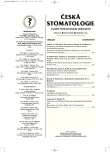Osteonecrosis of the Jaws in Treatment with Bisphosphonates
Osteonekróza čelistí při léčbě bisfosfonáty
Bisfosfonáty jsou nedílnou součástí komplexní léčebné strategie u nemocných, kde se vyskytují kostní metastázy nebo dochází k poruchám kostního metabolismu ve smyslu osteoporózy. Základní princip účinku bisfosfonátů spočívá v jejich selektivním vychytávání v kostech, kde tvoří ochrannou bariéru proti kostní destrukci. Inhibují kostní buňky-osteoklasty interferencí s metabolismem trifosfátů a mají významný antiangiogenní účinek, který je žádoucí proti nádorovým působením. Zpočátku jejich zavedení do léčby nebyly pozorovány účinky na porušení kvality kostní tkáně čelistí.
V našem souboru popisují autoři třináct nemocných ošetřovaných v období let 2003-2005, u nichž v průběhu dlouhodobé léčby bisfosfonáty nastaly po extrakci zubu (převážně v dolní čelisti) komplikace alveolitidou a dalším rozšířením nekrózy kosti. Podstatou těchto komplikací je porucha vaskularizace kostní tkáně, ke které přispívají vlastnosti molekul dusíku, které již moderní bisfosfonáty obsahují. Počáteční výrazně bolestivé projevy byly po konzervativní léčbě zklidněny, nedošlo však k vyhojení a u několika případů vznikla rozsáhlá ostitida až osteomyelitida. V jednom případě vznikla patologická zlomenina čelisti. Nekrotickou, uvolňující se kost, bylo nutno ošetřit chirurgicky, sekvestrotomií a parciální resekcí kosti bez porušení celistvosti čelisti. Průběh postextrakčních komplikací má obdobný charakter, jako je znám u ozářených čelistí se vznikem osteoradionekrózy. Stejně jako v těchto případech musí postupovat zubní lékař při plánování chirurgického ošetření obezřetně, dostatečně účinně zajistit nemocného antibiotiky, při vlastní extrakci maximálně snížit vasokonstrikční účinky lokálních anestetik, pečlivě ošetřit extrakční ránu a chránit krevní koagulum vytvořené v extrakční ráně. Pokud dojde ke komplikacím, musí zahájit velmi razantní dlouhodobou antibiotickou terapii podporovanou chirurgickými výkony k odstranění nekrotické a neregenerující kosti. Stejně jako před sanací onkologických nemocných, kde bude čelist ozářena, i při plánované léčbě bisfosfonáty je nutno provést extrakce zubů z preventivního časového pohledu.
Klíčová slova:
osteonekróza – bisfosfonáty
Authors:
M. Machálka 1; Z. Adam 2; O. Bulik 1; M. Kozumplíková 1
Authors‘ workplace:
Klinika ústní, čelistní a obličejové chirurgie LF MU a FN, Brno
přednosta doc. MUDr. M. Machálka, CSc.
1; Interní hematoonkologická klinika LF MU a FN, Brno
přednosta prof. MUDr. J. Vorlíček, CSc.
2
Published in:
Česká stomatologie / Praktické zubní lékařství, ročník 106, 2006, 5, s. 136-139
Overview
Bisphosphonates are an integral part of the comprehensive treatment strategy in patients in whom either bone metastases arise or bone metabolism disorders occur in terms of osteoporosis. Basic principle of the effect of bisphosphonates consists in their selective trapping in the bones where they create a protective barrier against bone destruction. By reason of interference with the metabolism of triphosphates, bisphosphonates inhibit the bone cells, i.e. osteoclasts and also contain an important anti-angiogenic effect, which is desired against the oncogenous activity. After introducing the bisphosphonates into treatment, initially no effect on quality of bone tissue of the jaw was observed. Nevertheless, some complications may occur after toot extraction. The authors present a file of thirteen patients who were treated with bisphosphonates on a long-term basis in 2003-2005 and in whom complications occurred after the tooth extraction (mainly in the mandible), caused by alveolitis and further increase of bone necrosis. The essence of these complications rests in disorder of the bone tissue vascularization due to the character of nitrogen molecules, which are included in modern bisphosphonates. Initially sharp painful symptoms calmed down after conservative treatment. Nevertheless, the afflicted area did not heal up completely and in some cases extensive ostitis up to osteomyelitis arose. In one case pathological fracture of the mandible occurred. The necrotic, disengaging bone was treated either by surgical intervention, sequestrectomy or by partial resection of the bone without destroying the integrity of the jaw. The character of post-extraction complications is similar to that of complications in case of osteoradionecrosis. When planning surgical treatment, dental surgeon must proceed very carefully and support the patient with an adequate dose of antibiotics. In the course of extraction the surgeon must decrease the vasoconstrictor effects of local anesthetics at the most, dress the wound carefully and protect the blood coagulum created in the wound. If any complications arise, the surgeon must immediately start an intensive long-term antibiotic therapy supported with surgical interventions for removing the necrotic and non-regenerating bone. Analogous to the situation in patients suffering from cancer, in whom first the tooth sanitation and afterwards the irradiation of the jaw will be performed, when planning the treatment by means of bisphosphonates the tooth extraction should be performed in accordance with the preventive time schedule.
Key words:
osteonecrosis – bisphosphonates
Labels
Maxillofacial surgery Orthodontics Dental medicineArticle was published in
Czech Dental Journal

2006 Issue 5
- What Effect Can Be Expected from Limosilactobacillus reuteri in Mucositis and Peri-Implantitis?
- The Importance of Limosilactobacillus reuteri in Administration to Diabetics with Gingivitis
Most read in this issue
- Osteonecrosis of the Jaws in Treatment with Bisphosphonates
- Aspergillomas of Maxillary Sinus
- Resorption of Augmenting Materials Used in Sinus Lift Operation
- Preservation of Alveolar Ridge after Preimplantation Tooth Extraction (A Review)
